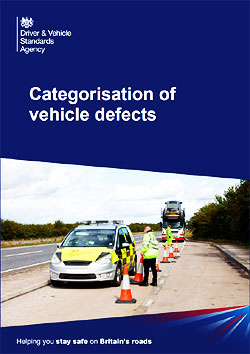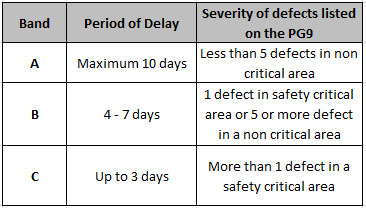
The Categorisation of Defects is, to an extent, the enforcement bible. However, it is not a legal document. It must not be treated as an interpretation of the relevant laws, which only the courts can provide.
The current version of the Categorisation of Defects was updated on 20 April 2022 and currently runs to 282 pages.
As a guide, the Categorisation of Defects tells you what actions Driver and Vehicle Standards Agency (DVSA) examiners and authorised constables can take when they find roadworthiness defects during:
You can use it to find out more about DVSA’s inspection standards and possible defects.
Updates are listed at the end of the document.
The Categorisation of Defects can be downloaded here.

An Overview
1. This Guide is intended primarily for the use of examiners within DVSA and Authorised Constables. However, it is made available more widely so that vehicle owners, operators and drivers can become more aware of DVSA’s standards.
Its purpose is:
2. The guide is not a legal document and must not be treated as an interpretation of the relevant legislation, which only the courts can provide.
Layout of the Guide
3. This publication is divided into three parts covering the main groups of road vehicles.
Part 1 is intended for heavy goods and public service vehicles and may be used for agricultural motor vehicles, trailers and trailed appliances (see note below).
Part 2 is for cars, private buses and light goods vehicles.
Part 3 is for motorcycles including combinations.
Note: An agricultural motor vehicle, trailer or trailed appliance is one that is constructed or adapted for use off roads for the purpose of agriculture, horticulture or forestry and which is primarily used for one or more of those purposes, but does not include a “dual-purpose” vehicle as defined in the Road Vehicles (Construction and Use) Regulations.
They fall into two distinct groups: those driven/ drawn at speeds not exceeding 20mph and those driven/drawn at speeds in excess of 20mph.
When using Part 1 of this document in connection with the inspection of an agricultural motor vehicle, trailer or trailed appliance the following exceptions must be noted.
For all types of agricultural vehicle IM references 3, 21, 24 and 33 will not apply.
NB: IM stands for Inspection Manual.
For types driven/drawn at speeds not in excess of 20mph the following IMs might not apply, or might apply in part only: IMs 5, 7, 8, 12, 14, 17, 22, 23, 24, 25, 26, 27, 48, 62 to 67 inclusive and 71 to 73 inclusive.
As a general rule, when inspecting these slower vehicles and using the IMs mentioned above, examiners should only be concerned with items that they find fitted. That is, a vehicle should not be considered defective if a particular item was not fitted as original equipment.
4. The page layout for all three parts is the same and consists of four columns.
Column 1: describes the defect;
Column 2: describes the severity of the defect;
Column 3: gives guidance on the action to be taken;
Column 4: gives guidance notes on standards and legal requirements.
A vertical black line alongside any text indicates a change from the previous version.
Policy on the Issue of Prohibitions
5. A Prohibition Notice (PG9) is a ban on the use of a vehicle on a public road. A prohibition will normally be issued where a vehicle is found by an examiner to be, or likely to become, unfit for use or where driving of the vehicle would involve a risk of injury to any person.
6. When a prohibition is in force it is an offence to drive or tow or permit to be used, a vehicle on the road unless an exemption notice has been issued or when certain circumstances as listed on the reverse of the prohibition notice apply.
7. In addition to preventing the further use of seriously defective vehicles on the road, prohibition notices are used:
Note 1: DVSA is required by law to send a copy of each prohibition to the relevant traffic commissioner.
Note 2: A commissioner can curtail, revoke or suspend licences on the basis of prohibitions, convictions or failure to comply with the conditions of holding a licence, one of which is the requirement to have arrangements for ensuring adequate maintenance.
8. A prohibition might take effect immediately or could be delayed for up to ten days. Immediate prohibitions are issued where, in the opinion of an examiner, the defects on the vehicle are such that further driving of it would involve a risk of injury to any person.
Where, in the examiner’s opinion, no such risk exists, the prohibition will come into force at such time, not later than 10 days from the date of the inspection (delayed prohibition) as seems appropriate to the examiner, having regard to all the circumstances, and will afterwards continue in force until it is removed.
A delayed prohibition allows continued use of the vehicle until the prohibition comes into force. The period of delay on prohibitions will reflect:
while taking into account the operational and financial implications for the operator.
Period of Delay Examiners will normally select one of the following periods of delay, which have been grouped together into three bands according to the number and severity of the defects listed on the prohibition notice (PG9):

Delayed Defect Concession
For roadside inspection, only under the following circumstances should a delayed prohibition be deviated (downgraded) to an inspection notice.
Where there is evidence that:
The delayed defect/s occurred on the current day’s journey (24-hour period).
and
The vehicle was clear of defects at the beginning of the current journey (24-hour period), supported by a nil driver defect report.
and
An in-service driver defect report, with recorded assessment (date and time) stating that the vehicle is safe to drive for the remaining current day’s journey.
or
That the vehicle is when encountered on direct route to a repair facility for delayed defect/s to be repaired.
and
There is evidence that the journey is directly to a place where the vehicle is to undergo repair for the delayed defect/s. (e.g. defect report with evidence the vehicle is directly on-route to the repair facility).
This applies to both GB and non-GB encounters
Important notes –
This concession does not apply if any other prohibition defect is detected on the encounter other than what is described above.
Under these circumstances, all defects should be actioned in accordance with this manual.
It is the responsibility of the driver to provide sufficient evidence at the time of the inspection for this concession to apply.
Definition of Safety Critical
Safety Critical defects or systems are those that could affect the control or directional stability of the vehicle. Throughout this guide, recommendations are indicated by a letter in the action column, as follows
“I” denotes an immediate prohibition
“D” denotes a delayed prohibition.
“IN” denotes an inspection notice
Advisory defects not considered serious enough to prohibit the vehicle. They are reported on a Vehicle Inspection Notice explained in the following paragraph. These are classed as ‘minor’
9. Notices Endorsed – Against each defect, it is necessary to categorise its significance in roadworthiness compliance and maintenance.
These are defects that the operator and / or driver should have been aware of through any or all of the following:
Defects(s) NOT considered to be maintenance related – ‘X’
Appropriate for defects of an entirely random failure nature such as a lighting bulb failure or a new fracture in a road spring leaf, having arisen through a random failure of a component, and where it is also apparent that it would not have been noticed by the driver.
Unable to determine whether a defect is attributable to poor maintenance:
If it is not possible to determine whether or not the operator, driver or the maintenance arrangements are culpable, then the defect is not endorsed.
10. Where examiners find on a vehicle roadworthiness defects not serious enough to warrant prohibition, they will advise the user/ owner using a Vehicle Inspection Notice. This notice is advisory only and does not in itself prevent further use of the vehicle.
Even if not prohibitable, some of the defects may mean that the vehicle is un-roadworthy and does not comply with the law. Continued use of a vehicle issued with either a Delayed Prohibition or a Vehicle Inspection Notice listing advisory defect(s) risks prosecution under the Road Vehicles (Construction and Use) Regulations or Road Vehicles Lighting Regulations and so it will be in the user’s interest to repair defects as soon as practicable after they are noticed.
Note: A Technical Roadside Inspection Report (PG35EC) will be issued following a HGV/ PSV spot check examination in place of a Vehicle Inspection Notice used for other vehicles. This will include any advisory defects.
Source – DVSA
There is much more here that should be looked at and digested by operators and transport managers alike. Ignorance of the changes and updates within the Categorisation of Defects is not an excuse.